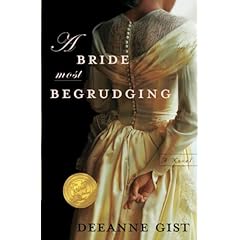
A Bride Most Begrudging won a Christy Award last year in the romance category. I’ll be honest: I picked the book because it had killer cover art. A woman in a Colonial wedding dress, her fingers crossed behind her back. Perfect. The scene on the cover doesn’t actually happen like so in the book, but man, what a great hook — and visual, too!
Reading it with an ubercritical eye, I found some storytelling problems: POV shifts mid-scene (a habit I’m trying to break - something I get called out for it on a weekly basis, so I’m sensitive to it in other people’s work), some anachronistic speech and sentiments (both very common in historicals, really), and inconsitency in dialogue (example: a character would say a few sentences in the same manner that we would, today, and then follow it up with “God ye go den.” I found it jarring — but I know firsthand how difficult it is to integrate historically authentic speech with phrasing and tones that a contemporary audience would understand.
The thing that really frustrated me, however, was the AsYouKnowBobbing. For the uninitiated, Wikipedia explains As You Know, Bob as this:
While giving readers information through dialogue can be an excellent way to slide in necessary information, writers can also attempt to give information through implausible dialogue. Most commonly, this occurs in the form of As You Know, Bob dialogue. This consists of characters giving each other –without motivation– long lectures about things the other characters know but the reader does not.
It slammed me in the face from the start, because I was Bobbed on page two. No kidding. Two characters told the entire setup to the opening scene to each other.
You see this a lot on soaps.
“Ever since your mother drove her Eddie Bauer Limited Edition SUV into our house, therefore destroying the only photograph of my sister who died mysteriously–but I think it was your father who killed her by pulling her hair out, strand by strand, the beast–and then stole my great uncle Wilbur’s ashes because the urn would fit her Rococo inspired living room, I haven’t been able to get along with her.”
All right, a minor exaggeration, but you get the point. Lots of backstory thrown in without a lot of grace. Even if the Rococo decor mattered to the plot, this is not how I’d want to find out about it.
The book wasn’t Bobbed continuously, though, but it popped up enough times (mostly to give character backstory or historical information about the Powahatan massacres) for me to mention it.
One more thing I have to say: I’m tired of heroines who flounce around for any portion of the book, their nose in the air, their prideful tongue their sword, their self-esteem their shield. You get a whole lot of this in girly books. Head. Desk. I don’t care how sensible and good and Mary Sue-riffic she is in her normal surroundings, if she’s not sensible when she’s faced with trouble, I’m gonna wanna smack her. Make your girl smart from the get-go. Not perfect, but give her some dynamic social graces, at least.
Okay, so I’ve ranted plenty.
Getting down and dirty: I enjoyed this book.
About midway through I found myself really rooting for all the characters, which is good enough for me. It’s a good story, and I really liked Constance’s growth — and yes, Drew was crush-worthy.
I think this is my longest critique yet.
No comments:
Post a Comment